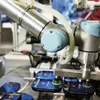How IoT will reshape the electronic manufacturing industry in 2021
The electronic manufacturing industry envisages an era of connected intelligent manufacturing by leveraging IoT and AI to automate the entire supply chain and production process.
IoT is fundamentally changing how businesses operate in the 21st century even though business operations globally have significantly evolved with the outbreak of the COVID-19 pandemic. The uncertainty and delays brought about by this catastrophe, especially in the electronic manufacturing industry has further encouraged players.
In an attempt to cope up with the disheartening setback to the industry, manufactures have been forced to re-evaluate their process, workforce safety and contingency plans. They have been able to do so by leveraging digital technologies to combat the challenges induced by the pandemic.
The introduction of IoT in the field of electronic manufacturing will not change the fundamental process of functioning, but will surely transform the way they are operated and managed.
It is projected that a well-though-out strategic application of this technology will lead to tangible advancement in four major sectors:
Connectivity
Making use of smart IoT-based equipment will enhance production quality and performance with a reduced workload. IoT-enabled machines would be able to self-process, store data whilst being digitally connected and enable the whole system to operate seamlessly.
The production equipment uses on-boarded data, IoT and sensors to operate in harmony. It simultaneously measures quality results and modifies settings basis the data generated to drive condition-based maintenance of the equipment.
The sensors will monitor the entire manufacturing process, from filtering the incoming materials to production of the final output. Manufacturing units will then be interconnected through a production system that will allow them to operate through self-optimisation and self-configuration to deliver comparatively superior products with cost-efficiency.
Speed and maintenance
Keeping a track of all the production processes and the outputs through manual measurements and management can only take place when a slot is ready. On the contrary, IoT sensor-based systems introduce you to real-time data collection and analysis of the ongoing production process, making it more responsive and therefore, hassle-free.
Besides this artificial intelligence-based systems have the potential to detect the root cause of deviations and are designed to identify and report a fault in the process/equipment along with generating and refining operation models for predictive maintenance. This will thus speed up upgrades by automatically identifying the gaps.
Accessibility and data management
This era of connected intelligent manufacturing will further facilitate the maintenance of all the required data at a place accessible through a single application. Monitoring the manufacturing process minute-by-minute and improvising the process as per demands of the consumer will lead to an appreciable transformation.
Available data and monitoring production process techniques can help the manufacturer foster relations with stakeholders and clients. They can be given access to the production system application that will allow them to track the quality of the material being used, along with the production time, current performance and improvement opportunities before the product is finalised. Thus, these measurements made during the process will help reduce the operational costs.
Smart manufacturing is what the future holds for the industry at large. Effectively integrating new technologies in the existing manufacturing framework will transform existing operations into highly connected, traceable, intelligent, and ultimately more productive factories.
Artificial intelligence will take on-board information and communication technology for the progression in the supply chain and production line, bringing an advanced level automation and digitisation.
(Disclaimer: The views and opinions expressed in this article are those of the author and do not necessarily reflect the views of YourStory.)








